Conducting Prior Art Searches? Translate Images In Non-English Literature Too!
Detailed illustrations or images assist in understanding the written text in patent and non-patent literature. While illustrations in patent documents mainly cover product-related drawings and processes, images in non-patent documents can include anything from pictures on posters-to-labels on products. Since these images are a part of patent and non-patent literature and can be used as evidence by examiners to reject patent applications, searchers must analyze them thoroughly. Besides looking for images in English documents, it is also important to search them in non-English documents for obtaining comprehensive results. In line with the above, this article explains the importance of translating images contained in native patent and non-patent documents while carrying out prior art searches.
Table of Contents
What is Non-English Literature?
Non-English Literature refers to any literature found in a language other than English. In prior art searching, non-English literature comprises of native patent and non-patent literature that can exist in the form of research papers, videos, product brochures, product packaging, comic books, etc.
When it comes to non-English patent literature, data from Questel Orbit and WIPO shows that ten countries (China, U.S., Germany, France, the Netherlands, Italy, Japan, Korea, Switzerland, and Great Britain) contribute to almost 75% of the total patents filed around the world. Out of these, eight countries namely China, Germany, France, the Netherlands, Italy, Japan, Korea, and Switzerland prefer filing patents in their native, i.e., non-English language.
Importance of Searching Literature Beyond the English Language
As mentioned above, while looking for non-English literature during prior art searches, we consider both patent and non-patent documents. This is because information related to an invention can be found in either of them. Conducting an exhaustive non-English search ensures that the applicants do not miss out on any documents relevant to their inventions.
While native searchers can easily find non-English documents related to an invention, searchers who only understand English need accurate translations of such documents to identify the relevant ones. English language searchers can use machine translation tools such as Google Translate to understand the native patent and non-patent documents. However, these tools are still in their nascent stages and hence searchers should not completely rely on machine-translated texts to get accurate search results.
Interpreting Images Present in Non-English Literature
In case of non-English patent literature, the translation of an image assists in understanding the details of an invention. For instance, in most AI-based or communication-related inventions, the images are present in the form of flow charts that are essential to depict the correct flow of the invention. When these charts are available in a non-English language, it becomes crucial to convert them into English language with the help of a native language expert. This is because sometimes these charts are interpreted incorrectly due to machine translation errors. Given below are two images depicting the same patent image from a non-English patent before and after translation.

Fig.1: Patent Image before Translation

Fig.2: Patent Image after Translation
Even in case of non-patent literature, it is imperative to translate the non-English images to ensure that searchers do not miss out on any important detail. To help you understand this better, let us take an example.
Suppose a searcher needs to identify prior arts for a patent related to a chewing gum using a special type of sweetener (novel sweetener). A comprehensive search reveals a non-patent prior art – a chewing gum (available for sale in China) whose composition is written on the product packaging. In such a scenario, by translating the image on the packaging, the searcher can easily check whether the identified chewing gum discloses the use of the novel sweetener.
Conclusion
Since carrying out foreign language searches can be tricky for most businesses, they can avail services from companies such as ours. Sagacious IP deploys a dedicated Foreign Language Search team with expertise in over 15 major global languages including Mandarin, German, French, Japanese, Korean, Dutch, Spanish, and Italian, thereby allowing you to conduct more targeted and thorough patent searches. Click here to view the webinar on this subject.
-Rohit Joshi (Engineering Searching) and The Editorial Team




